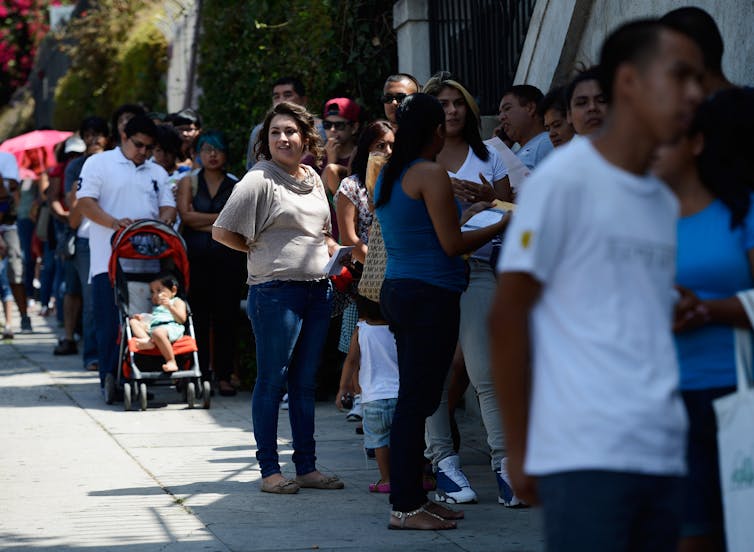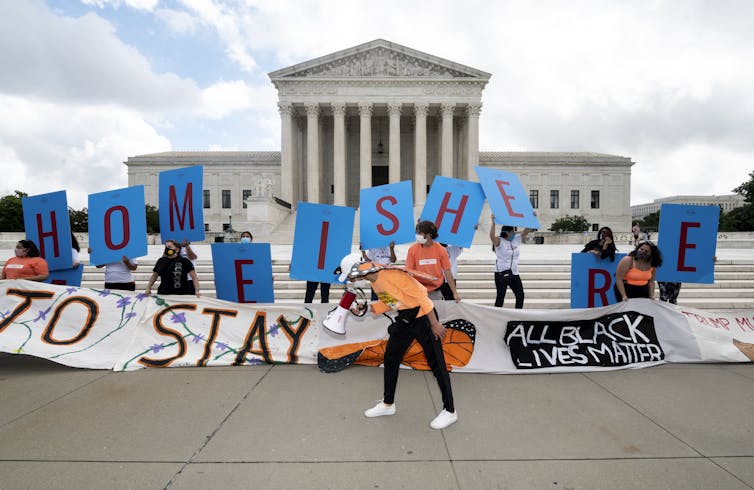Citizenship for the 'Dreamers'? 6 essential reads on DACA and immigration reform
- Written by Catesby Holmes, International Editor | Politics Editor, The Conversation US
The United States could eventually grant citizenship to roughly 2.5 million undocumented immigrants brought to the country as children.
The American Dream and Promise Act of 2021[1], which passed in the Democrat-dominated House of Representatives on March 18, would give a group known as the “Dreamers” permanent resident status for 10 years. They could then apply to be naturalized as U.S. citizens.
Only nine House Republicans voted for the bill, so in its current form it is unlikely to pass the Senate, which is split evenly between Democrats and Republicans. For over a decade, all congressional efforts to protect Dreamers have died in the Senate[2].
In 2012, President Barack Obama bypassed Congress with an executive order to help this group of immigrants. The Deferred Action for Childhood Arrivals[3], or DACA, granted the temporary right to live, study and work to about 800,000 undocumented immigrants age 30 or younger who had come to the U.S. before age 16.
President Donald Trump rescinded DACA in fall 2017[4], asking Congress to resolve the Dreamers’ legal limbo by March 2018. Congress hasn’t passed any legislation to resolve Dreamers’ status; the American Dream and Promise Act is an effort to attempt that.
Here’s some key background and expert analysis on the “Dreamers” and DACA as the debate advances to the Senate.
1. DACA’s results
Researchers who evaluated DACA found the program benefited both Dreamers and the United States.
Wayne Cornelius, a professor emeritus of U.S.-Mexican relations at the University of California, San Diego, led a research team that interviewed dozens of DACA recipients in 2014[5]. He found that work permits enabled them to get higher-paying jobs.
“This made college more affordable and increased their tax contributions. DACA [also encouraged] them to invest more in their education because they knew legal employment would be available when they completed their degree,” Cornelius wrote in 2017.
A survey conducted earlier that year of some 3,000 DACA recipients found that 97% were currently employed or enrolled in school, and many had started their own businesses.
 Young immigrants line up to apply for DACA on Aug. 15, 2012, in Los Angeles.
Kevork Djansezian/Getty Images[6]
Young immigrants line up to apply for DACA on Aug. 15, 2012, in Los Angeles.
Kevork Djansezian/Getty Images[6]
But DACA had “significant limitations,” according to Cornelius. Because their work authorization had to be renewed every two years, for example, some employers were reluctant to hire Dreamers.
2. Undocumented stress
Still, research found, DACA enabled recipients “to further their education and obtain jobs and health insurance,” wrote migration specialists Elizabeth Aranda and Elizabeth Vaquera[7] in September 2017.
The program gave the Dreamers “peace of mind – something that, until then, was unfamiliar to them.”
3. DACA and the wall
Nearly 80% of DACA recipients came from Mexico. So when the Trump administration in September 2017 set DACA protections to expire within six months, the decision affected Mexico, too.
“Ending DACA exposes 618,342 undocumented young Mexicans” to deportation, wrote political scientist Luis Gómez Romero[8].
Gómez Romero said the DACA decision could be read as “a power play in Trump’s ongoing battle with the government of Mexico” over its refusal to pay for a border wall.
4. Congressional battles
By early 2018, with DACA soon to expire, Congress was in a “scramble for a solution,”[9] according to Kevin Johnson, a dean and professor of Chicana/o studies at the University of California, Davis. That month, a congressional showdown over the Dreamers closed the federal government for 69 hours.
While “some conservatives have balked at the idea of giving ‘amnesty’ to any lawbreakers,” he wrote, some progressives found DACA too narrow.
According to the Migration Policy Initiative, DACA excluded about 1 million unauthorized immigrants who met most criteria for DACA but had not completed their education, had committed a crime or feared applying to DACA because of worry their undocumented parents could be deported.
Trump reentered the fray in January 2018 with a proposed path to legalization for 1.8 million Dreamers. The trade-off for siding with Democrats: Congress had to fund his U.S.-Mexico border wall.
That proposal, too, failed.
5. Supreme Court decisions
The Dreamers’ plight has forced the Supreme Court to get involved on several occasions.
In 2017 the court issued an injunction on Trump’s termination of the program, allowing DACA recipients to renew their protected status for another two-year period while other lawsuits proceeded. In June 2020, the court ruled the Trump administration could not actually dismantle DACA because it had not provided adequate justification for doing so.
 Dreamers celebrate the Supreme Court’s DACA decision on June 18, 2020.
Bill Clark/CQ-Roll Call via Getty Images[10]
Dreamers celebrate the Supreme Court’s DACA decision on June 18, 2020.
Bill Clark/CQ-Roll Call via Getty Images[10]
That gave the Dreamers another respite, but DACA remained in danger because the 2020 ruling “was not about whether the president of the United States has the authority to rescind DACA,” wrote political scientist Morgan Marietta of the University of Massachusetts, Lowell[11]. “All of the parties involved agreed that he does.”
The case merely confirmed that a president cannot lie about the rationale underlying his executive orders.
The justices’ narrow decision left open the “possibility that the administration could try to rescind DACA at a later date,” wrote Marietta.
6. Biden and immigration reform
Joe Biden’s election forestalled that. His administration is pushing Congress to undertake comprehensive immigration reform that would create pathways to citizenship not only for the Dreamers but also for other undocumented immigrants, including farmworkers.
Any immigration overhaul must tackle a host of new challenges created over the past four years[12], according to Miranda Cady Hallett, a Central America immigration expert at the University of Dayton.
[Deep knowledge, daily. Sign up for The Conversation’s newsletter[13].]
Trump made over 400 changes to immigration policy, by Hallett’s tally, including barring immigrants from several Muslim-majority countries and separating families at the border.
While many presidents have deported large numbers of undocumented immigrants, Trump’s immigration enforcement was “more random and punitive,” writes Hallett. It “vastly increas[ed] criminal prosecutions for immigration-related offenses and remov[ed] people who have been in the U.S. longer.”
That includes the Dreamers.
After a decade of legal battles and political threats, the Dreamers aren’t so young anymore. Many in the original group of 800,000 are pushing 40.
References
- ^ American Dream and Promise Act of 2021 (www.congress.gov)
- ^ have died in the Senate (www.politico.com)
- ^ Deferred Action for Childhood Arrivals (obamawhitehouse.archives.gov)
- ^ rescinded DACA in fall 2017 (www.npr.org)
- ^ led a research team that interviewed dozens of DACA recipients in 2014 (theconversation.com)
- ^ Kevork Djansezian/Getty Images (www.gettyimages.com)
- ^ wrote migration specialists Elizabeth Aranda and Elizabeth Vaquera (theconversation.com)
- ^ political scientist Luis Gómez Romero (theconversation.com)
- ^ a “scramble for a solution,” (theconversation.com)
- ^ Bill Clark/CQ-Roll Call via Getty Images (www.gettyimages.com)
- ^ wrote political scientist Morgan Marietta of the University of Massachusetts, Lowell (theconversation.com)
- ^ host of new challenges created over the past four years (theconversation.com)
- ^ Sign up for The Conversation’s newsletter (theconversation.com)
Authors: Catesby Holmes, International Editor | Politics Editor, The Conversation US


